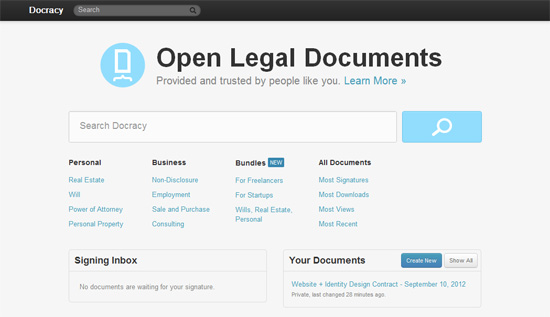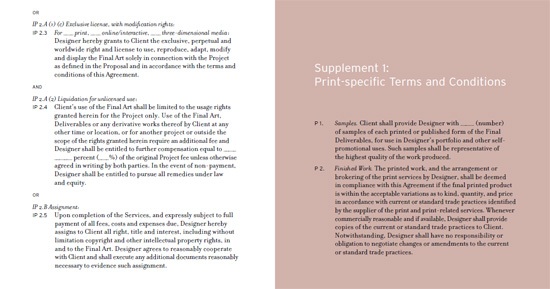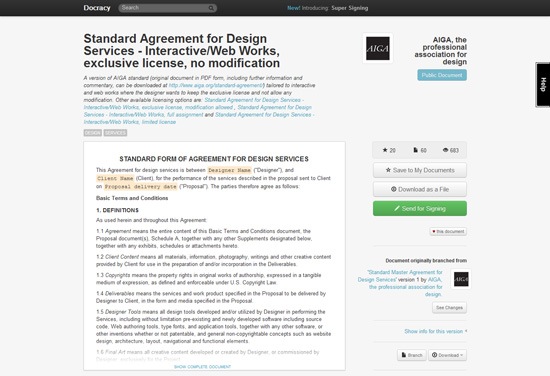- Home
- Blog
- Web Design 6 Good Tips for Your Freelance Design Contracts
6 Good Tips for Your Freelance Design Contracts
-
 7 min. read
7 min. read
-
 William Craig
William Craig CEO & Co-Founder
CEO & Co-Founder
- President of WebFX. Bill has over 25 years of experience in the Internet marketing industry specializing in SEO, UX, information architecture, marketing automation and more. William’s background in scientific computing and education from Shippensburg and MIT provided the foundation for MarketingCloudFX and other key research and development projects at WebFX.
 In freelance work, having legal contracts between you and the clients you work with is important. Contracts legally protect you and your business in various ways and helps in making sure that you’re properly compensated for the work that you do. What follows are a few tips you should keep in mind when you’re drafting your contracts for your design services.
In freelance work, having legal contracts between you and the clients you work with is important. Contracts legally protect you and your business in various ways and helps in making sure that you’re properly compensated for the work that you do. What follows are a few tips you should keep in mind when you’re drafting your contracts for your design services.
Though we’ve focused on the needs of designers, these tips are also applicable to a wide range of professions (especially creative services professions).
1. Always Have a Written Contract
Don’t just agree to performing freelance work by shaking hands with the client or replying “OK!” to an email. You should always have a written contract that summarizes the work to be done, the business terms and other legal details that might be boring to read, but can actually save you a lot of trouble down the road. Sample contracts aren’t hard to find, but of course, an attorney is a good first option to take.
If you’re lacking the funds for hiring a good lawyer, see if you have legal pro bono associations (like Volunteer Lawyers for the Arts) around your area that you can look into. Also, there are some websites that sell legal document templates such as LegalZoom and U.S. Legal Forms.
 You can find legal documents and get answers to legal questions on sites like LegalZoom. There are also some free internet sources that provide contract templates and guidelines for designers, such as Docracy (full disclosure: I work at Docracy) and the AIGA.
You can find legal documents and get answers to legal questions on sites like LegalZoom. There are also some free internet sources that provide contract templates and guidelines for designers, such as Docracy (full disclosure: I work at Docracy) and the AIGA.  Docracy provides socially-curated, free legal-agreement resources. You can even take your chances by searching for design contract templates on Google.
Docracy provides socially-curated, free legal-agreement resources. You can even take your chances by searching for design contract templates on Google.
2. Don’t Assign Rights to Your Work Before You’re Paid
This is one of the most common mistakes that people who provide creative services make: Giving up the rights to their work before they’ve been compensated. How do you make sure that your design contract prevents this situation? Look for wording like this: “upon completion of the services and conditioned upon full payment…” Here’s an example from the Website + Identity Design Contract template:
Upon completion of the Services and full payment of all invoices, the Designer shall assign IP rights to the Client.
These IP rights include all ownership rights, including any copyrights, in any artwork, designs and software created by the Designer and incorporated into a Final Deliverable, except as otherwise noted in this Agreement.
3. Have a Kill Fee
You should have a fee for projects that are unexpectedly terminated or projects where your client changes their mind and no longer wishes to continue. Temper your kill fee with clear milestones, making sure to have written proof of acceptance for each deliverable. In a contract, the kill fee is usually covered in the “Cancellation” clause.
Here’s an excerpt from the Designer sample contract template that outlines a kill fee:
In the event of cancellation of this assignment, ownership of all copyrights and the original artwork shall be retained by the Designer, and a cancellation fee for work completed, and expenses already incurred, shall be paid by the Client. Cancellation fee is based on the hours submitted, if the project is on an hourly basis or a percentage based on the time estimate for the entire job. A 100% cancellation fee is due once the project has been finished, whether delivered to the client or not.
If the project is on an hourly basis and project is canceled by the client, the client agrees to pay no less than 100% of the hours already billed for the project at the time of cancellation plus a flat fee of $250 or 50% of the remaining hours that were expected to be completed on the project, whichever is greater.
4. Have a Good, Solid Statement of Work
If you’re starting from any decent contract template, it’s a bad idea to start modifying the legal clauses without the help of an attorney because altering the text might affect the goals, effectiveness and validity of the contract. However, one of the parts that you have flexibility over is the statement of work. You need to modify this part so that it’s relevant to the project you’re about to embark on.
The statement of work helps avoid project scope creep by outlining what your deliverables are and what you’re required to do. A good statement of work should give you the basis to charge additional fees for work beyond what you’ve initially agreed to do. If you’re afraid that your clients will keep trying to expand the scope of the project, be as specific as possible, so you then have grounds to charge extra for additional work.
At other times (particularly in longer and more unpredictable projects), being vague may be preferable.
5. Make Your Contract Look Professional and Beautiful
Who said legal documents need to look boring? As long as your contract has all the essential parts, you’re free to improve it and turn into an actual object of design. After all, it’s something coming from your desk and therefore contributes to your brand as much as a business card does.
Additionally, a professional and beautiful contract can give the client more confidence about working with you.  Two pages from the AIGA standard form of agreement PDF. Here are a few tips for improving the layout and typography of legal text (mostly focused on making text easier to read):
Two pages from the AIGA standard form of agreement PDF. Here are a few tips for improving the layout and typography of legal text (mostly focused on making text easier to read):
- Don’t use underlined text (it makes text harder to read)
- Avoid using too much italics and all-caps
- Colors are not a great idea (except on the personalized letterhead of your contracts)
- Prefer serif fonts for the body (but feel free to choose a modern sans serif for headings)
- Use ample white space in margins
- Have ample line spacing (ideally, 120–145% of the font size according to Typography for Lawyers)
- Page numbers are essential in longer contracts, and usually placed in the footer. Don’t forget them!
Legal stuff is not the most entertaining to read, so it needs all the help it can get!
6. Talk to a Lawyer
While sometimes it’s not financially viable to go to a lawyer, there are certain situations that would greatly benefit from consulting a lawyer. For example, if the client starts making a lot of changes or starts saying stuff like “it’s standard” or “we do this all the time”. Few things are non-negotiable in service contracts, and this is usually an excuse to throw in a provision that, invariably, will not benefit your side. Designer contracts are pretty standardized, thanks to the work of AIGA. Don’t be afraid of pointing the client to this model contract to show what the standards of your industry are.
 If the contract you’re signing is from the client and something doesn’t sound quite right, have your lawyer take a look at the contract before you sign. Read everything closely before signing, and compare the terms with designer-friendly contracts available on the Web (such as those mentioned above).
If the contract you’re signing is from the client and something doesn’t sound quite right, have your lawyer take a look at the contract before you sign. Read everything closely before signing, and compare the terms with designer-friendly contracts available on the Web (such as those mentioned above).
Conclusion
Keep in mind that this article is meant to share some tips on drafting contracts, but it’s not legal advice.
All the legal documents cited should be used only as a starting point. Don’t forget that legal stuff is important, and a good lawyer can help you review these examples and tailor them to your particular project and local laws.
Related Content
-
 President of WebFX. Bill has over 25 years of experience in the Internet marketing industry specializing in SEO, UX, information architecture, marketing automation and more. William’s background in scientific computing and education from Shippensburg and MIT provided the foundation for MarketingCloudFX and other key research and development projects at WebFX.
President of WebFX. Bill has over 25 years of experience in the Internet marketing industry specializing in SEO, UX, information architecture, marketing automation and more. William’s background in scientific computing and education from Shippensburg and MIT provided the foundation for MarketingCloudFX and other key research and development projects at WebFX. -

WebFX is a full-service marketing agency with 1,100+ client reviews and a 4.9-star rating on Clutch! Find out how our expert team and revenue-accelerating tech can drive results for you! Learn more
Make estimating web design costs easy
Website design costs can be tricky to nail down. Get an instant estimate for a custom web design with our free website design cost calculator!
Try Our Free Web Design Cost Calculator


Web Design Calculator
Use our free tool to get a free, instant quote in under 60 seconds.
View Web Design CalculatorMake estimating web design costs easy
Website design costs can be tricky to nail down. Get an instant estimate for a custom web design with our free website design cost calculator!
Try Our Free Web Design Cost Calculator





